Contact: Pavel Kubeš
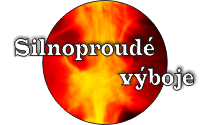
We are a group at the department of physics, working in the field of basic research of hot and dense plasma, especially focusing on the high-current lightning-like discharges.
We participate in the education of the students, mostly in the PhD study program Plasma physics (at FEE CTU) and in the advanced part of the masters course at FNSPE CTU in Prague (course Physics and technique of thermonuclear fusion).
Team members
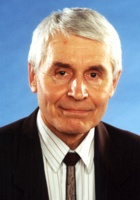 |
prof. RNDr. Pavel Kubeš, CSc.
Group leader. Responsible for the experiments held on the PF-1000 device in Warsaw. Manages the cooperation with the Kurchatov institute in Moscow. Specializes in processing and interpretation of the results. Principal investigator of most of the projects, which finance the activity of the group. Headmaster of International Scientific Committee of Dense Magnetized Plasmas. Trained 8 postgraduate students and presently leads 3 more.
|
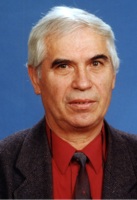 |
doc. Ing. Jozef Kravárik, CSc.
Headmaster of the Laboratory of high-current discharges at the Department of physics, member of the group, associate professor. Responsible for the preparation and testing of diagnostics. Specializes in laser diagnostics of the plasma. Responsible for the device PFZ-200, which is one of the few university devices, which can produce fusion neutrons.
|
 |
doc. Ing. Daniel Klír, Ph.D.
Member of the group, associate professor. Specializes in the plasma diagnostics, physics of the Z-pinch and controlled thermonuclear synthesis. Responsible for the experiments held on the GIT-12 device in Tomsk, cooperation with CCHEN in Chile, with FNSPE CTU in Prague, NPI and IP AS CR v.v.i. in Prague. Since 2012 is also an independent scientific worker in the project ELI Beamlines.
|
 |
Ing. Karel Řezáč, Ph.D.
Member of the group, supervising person for the regulatory compliance of the radiation safety in the laboratory of high-current discharges. Specializes in numerical simulations for plasma diagnostics (reconstruction of the energetic spectra of the fusion neutrons). Further specializes in design, realization and preparation of diagnostic devices. Manages the cooperation with the FME CTU in Prague, CMI in Prague and the cooperation with the company Envinet a.s.
|
| Ing. Balzhima Batobolotova
Postgraduate student. Specializes in the central setting and control of the diagnostic with system LabVIEW and processing of the obtained data. General theme of the PhD thesis: Experimental diagnostics of the hot dense impulse plasma.
|
|
| Ing. Jakub Cikhardt
Postgraduate student. Specializes in the design, realization and testing of electronic diagnostic devices. General theme of the PhD thesis: Diagnostic of the energetic processes inside hot plasma.
|
|
| Ing. Jiří Kortánek
Postgraduate student. Specializes in computer processing of the images obtained by various diagnostic devices (interferometry, bubble detectors, streak camera etc.). Theme of the PhD thesis: Interferometry diagnostic of the Z-pinch structures.
|
|
| Ing. Ondřej Šíla
Postgraduate student. Specializes in numerical simulations with the MCNP code, which can simulate the propagation of the electromagnetic radiation, neutrons etc. through various materials. These simulations are important for design and construction of the diagnostic devices and also help with the proper positioning and setting. Further serve for better understanding of the measured data. General theme of the PhD thesis: Diagnostics of the fusion neutrons in Z-pinch discharge.
|
New team member
We will gladly welcome another member of the team in any position, for example: PhD student, scientific worker, under-graduate student making bachelor or masters thesis… The main condition is not excellent knowledge, but enthusiasm, be it in electronics, measurement, numerical simulations etc. (our work is not only about physics).
Research directions
High-current lightning-like discharges, the so-called Z-pinches, are presently the most efficient (>15 %) and most powerful (500 000 GW, 2 MJ) laboratory sources of the X-ray radiation. In the recent years there was also a surprising discovery, that in the imploding Z-pinches, the ion temperature can be higher than 200 keV, which is 2×109 K, which represents the highest ion temperature measured in a laboratory.
We specialize in diagnostic of various kinds of radiation (visible, soft and hard X-ray), electrons, ions and neutrons and in diagnostic of electrical variables. Further we describe the processes, which occur in the dense magnetized plasma.
In the plasma created by big lasers or Z-pinch discharges also fusion reactions can occur. Study of the neutrons originating from D(d,n)3He fusion reaction is carried out by the team members in the Laboratory of high-current discharges at FEE and mainly abroad, cooperating with the teams in the Russian federation and Poland.
What is it good for?
Our experimental results have wide possibility of usage in the following fields of study:
- development of a new energy source
- development of a cheap source of fast neutrons
- laboratory Astrophysics,
- research of plasma in strong magnetic field
- EUV lithography
- research of warm dense matter
- testing of material in nuclear weapon research
- development of RTG lasers, etc.
A part and a great advantage of our research are the possibilities of education and direct students contributions to the experiments. Thanks to the individual approach of the experienced members of the team and thanks to the hardworking students, enthusiastic for the subject, quality student works are produced.
What are we working on?
PFZ-200 at FEE CTU in Prague
The home work-site for our research is the laboratory of high-current discharges at Department of physics at FEE CTU in Prague. Here we have a relatively small device PFZ-200. It is a small modified plasma focus. In its inner chamber we can produce a plasma column with 200 250 kA of current. The device PFZ-200 is used for: (i) Preparation and testing of the dense plasma diagnostics, which is then used for another, much bigger devices abroad. (ii) Basic research, where we study the means of accelerating the ions in the dense plasma and production of the fusion neutrons. For illustration we show the next picture, where time-evolution of the pinch discharge is shown. The pictures were made with a pin-hole camera with a MCP detector with 5 nanoseconds of exposition time. (iii) For teaching purposes in the bachelor, master and PhD study courses.

 During the discharges in the device PFZ-200, acceleration of ions and electrons to high energies occurs. In these conditions X-ray radiation is generated and more energetic particles can be produced. In the case of using heavy hydrogen (deuterium) as a filling gas, fusion neutrons can be produce as well. That is why the operation of the PFZ-200 device at FEE CTU in Prague must be approved by the State Office for Nuclear Safety. Our device was classified as a simple source of ionizing radiation. It is one of the few university devices in the world, where there is the possibility to produce and measure fusion neutrons.
During the discharges in the device PFZ-200, acceleration of ions and electrons to high energies occurs. In these conditions X-ray radiation is generated and more energetic particles can be produced. In the case of using heavy hydrogen (deuterium) as a filling gas, fusion neutrons can be produce as well. That is why the operation of the PFZ-200 device at FEE CTU in Prague must be approved by the State Office for Nuclear Safety. Our device was classified as a simple source of ionizing radiation. It is one of the few university devices in the world, where there is the possibility to produce and measure fusion neutrons.
PF-1000 in IPPLM in Warsaw
The plasma focus device PF-1000, located in the Institute of Plasma Physics and Laser Microfusion (IPPLM) in Warsaw represents a powerful source of fusion neutrons on a medium-sized device, with currents up to 2 MA. Plasma generated by this device can be studied by a complex X-ray, neutron, interferometric and probe diagnostic in the frame of International Scientific Committee of Dense Magnetized Plasmas (ICDMP) research. In the last year the research was oriented on the study of the influence of vaporized electrode materials, on the study of the external magnetic field and on the properties of the deuterium plasma imploded by the heavier gas, for example neon.
On the left picture we present a group photo from the year 2009 in IPPLM in the front of the PF-1000 device. On the right picture you can see the visualization of the plasma discharge of the plasma focus type. The time evolution of the electron density is showed, which was reconstructed from 15 interferometry figures.
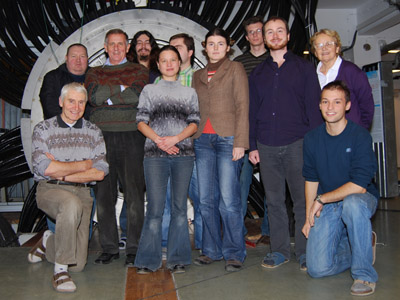
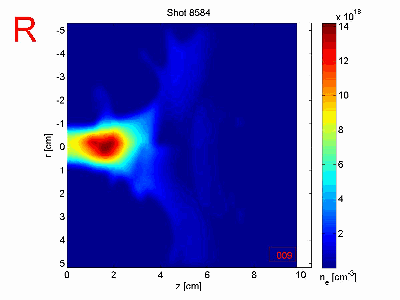
GIT-12 in IHCE in Tomsk
Since 2011 we cooperate with the group of Dr. Alexander Shishlov from Institute of high-current electronics (IHCE) in Tomsk, which is located in a Siberian part of Russian Federation. In this location a special generator of current pulse GIT-12 is placed. It is a terawatt generator, able to produce a current pulse with 5 MA of current and with rise-time to maximum in 250 nanoseconds or 1 microsecond. Few of the most important result lately (year 2013) are the achievement of highest observed energy of neutrons (>20 MeV) and ions (>25 MeV) in Z-pinches and second highest yield from the fusion D(d,n)3He reaction on Z-pinches (4×1012 neutrons in one shot), which means highly effective production of the fusion neutrons with intensity 1020 reactions per second.
For illustration we show on the next picture the neutron time-of-flight signals from the year 2012, which were measured by four detectors in various distances (shown left) and the reconstructed time-evolution of energy spectrum of the fusion neutrons by Monte Carlo methods (right). This neutron diagnostic is one of the most important diagnostic we use and thanks to it we can get greater understanding about the production of the fusion neutrons than other foreign workgroups. On the lower picture you can see time-integrated picture of the Z-pinch discharge, which was obtained with a pin-hole camera with diameter 100 micrometers and beryllium filter with width 25 micrometers. There are two pictures from different discharges from the year 2011 (No. 1408 and No. 1409).
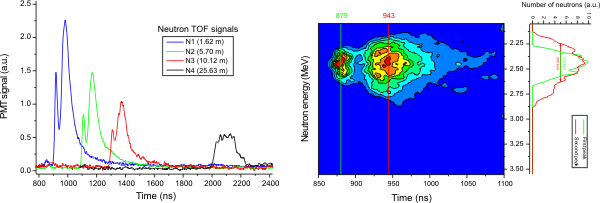
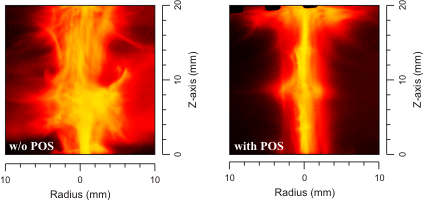
Other scientific work
Apart from experiments, which we design, prepare and realize on the devices PFZ-200, PF-1000 and GIT-12, we are also contacted a few times during the year with a request to operate diagnostics on other devices (laser PALS in Prague, experiments in GSI in Darmstadt, in CCHEN in Chile). For illustration we present photographs from the interaction room at the PALS laser in Prague (left) and PHELIX laser in Darmstadt (right).
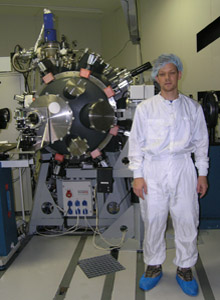

Sponsors of our research
Our research is supported mainly by MEYS of CR, GA CR (Czech Science Foundation), CTU in Prague and IAEA. Selected research projects follows:
- MEYS of CR, INGO LG13029: Research in Frame of the International Center for Dense Magnetized Plasmas
- MEYS of CR, Contact ME090871: Research of terawatt Z-pinches
- GA CR grant No. P205/12/0454: Efective production of fusion neutrons in Z-pinches and laser-produced plasma
- Student grant of CTU in Prague No. 10/266/OHK3/3T/13: Electrical discharges, basic research and application
- Program IAEA RC 17088: Characterization of High Energy Deuteron Pulses Produced by Dense Magnetized Plasmas
Our partners
World co-operation
- Institute of Plasma Physics and Laser Microfusion (IPPLM) in Warsaw, Poland
- Institute of High Current Electronics (IHCE) SB RAS in Tomsk, Russian Federation
- Comisión Chilena de Energía Nuclear (CCHEN) in Santiago de Chile, Chile
- GSI Helmholtzzentrum für Schwerionenforschung (GSI) in Darmstadt, Germany
- National Research Center Kurchatov Institute (NRC KI) in Moscow, Russian Federation
Co-operation in Czech Republic
- Ústav fyziky plazmatu (ÚFP) AV ČR v.v.i. v Praze.
- Fyzikální ústav (FÚ) AV ČR v.v.i. v Praze.
- Fakulta strojní (FS) ČVUT v Praze.
- Fakulta jaderná a fyzikálně inženýrská (FJFI) ČVUT v Praze.
- Český metrologický institut (ČMI) – Inspektorát pro ionizující záření.
- Ústav jaderné fyziky (ÚJF) AV ČR v.v.i. v Praze – Oddělení dozimetrie záření.
Envinet a.s.
Selected publications
Journal papers
Because big number of our publications and publications of our co-workers, only journal papers from 2012 follows:
- P. Kubes, D. Klir, J. Kravarik, K. Rezac, M. Paduch, T. Pisarczyk , M. Scholz, T. Chodukowski, I. Ivanova-Stanik, L. Karpinski, K. Tomaszewski, E. Zielinska, M. J. Sadowski: Energy Transformation in Column with Plasma Focus Discharge with MA Currents. IEEE Transactions on Plasma Science 40 (2012), 481-486.
- P. Kubes, D. Klir, M. Paduch, T. Pisarczyk , M. Scholz, T. Chodukowski, Z. Kalinowska, K. Rezac, J. Kravarik, J. Hitschfel, J. Kortanek, B. Bienkowska, I. Ivanova-Stanik, L. Karpinski, M. J. Sadowski, K. Tomaszewski and E. Zielinska: Characterization of the Neutron Production in the Modified MA Plasma-Focus. IEEE Transactions of Plasma Science 40 (2012), 1075-1080.
- P. Kubes, D. Klir, K. Rezac, M. Paduch, T. Pisarczyk , M. Scholz, T. Chodukowski, Z. Kalinowska, J. Hitschfel, J. Kortanek, J. Kravarik, I. Ivanova-Stanik, B. Bienkowska, L. Karpinski, E. Zielinska, M. J. Sadowski, K. Tomaszewski: Interferometry of the Plasma Focus Equipped with Forehead Cathode. Nukleonika 57, 189-192.
- P. Kubes, V. Krauz, K. Mitrofanov, M. Paduch, M. Scholz, T. Pisarczyk , T. Chodukowski, Z. Kalinowska, L. Karpinski, D. Klir, J. Kortanek, E. Zielinska, J. Kravarik, K. Rezac: Correlation of Magnetic Probe and Neutron Signals with Interferometry Figures on the Plasma Focus Discharge. Plasma Phys. Control. Fusion 54 (2012), 105023.
- Klir, D., Kubes, P., Paduch, M., Pisarczyk, T., Chodukowski, T., Scholz, M., Kalinowska, Z., Bienkowska, B., Karpinski, L., Kortanek, J., Kravarik, J., Rezac, K., Ivanova-Stanik, I., Tomaszewski, K., Zielinska, E.: Search for thermonuclear neutrons in a mega-ampere plasma focus. Plasma Phys. Control. Fusion 54 (2012), 015001.
- Klir, D., Kubes, P., Paduch, M., Pisarczyk, T., Chodukowski, T., Scholz, M., Kalinowska, Z., Zielinska, E., Bienkowska, B., Hitschfel, J., Jednorog, S., Karpinski, L., Kortanek, J., Kravarik, J., Rezac, K., Ivanova-Stanik, I., Tomaszewski, K.: Response to “Comment on ‘Experimental evidence of thermonuclear neutrons in a modified plasma focus'”. Appl. Phys. Lett. 100 (2012), 016102.
- Klir, D., Shishlov, A. V., Kubes, P., Rezac, K., Fursov, F. I., Kokshenev, V. A., Kovalchuk, B. M., Kravarik, J., Kurmaev, N. E., Labetsky, A. Yu, Ratakhin, N. A.: Deuterium gas puff Z-pinch at currents of 2 to 3 mega-ampere. PHYSICS OF PLASMAS 19 (2012), 032706.
- Klir, D., Soto L.: Drive parameter of neutron-optimized dense plasma foci. IEEE Transactions of Plasma Science 40 (2012), 3273-3279.
- K. Rezac, D. Klir, P. Kubes and J. Kravarik: Improvement of time-of-flight methods for reconstruction of neutron energy spectra from D(d,n)3He fusion reactions. Plasma Phys. Control. Fusion 54 (2012), 105011.
- Klír, D., Kokshenev, V., Kubeš, P., Labetsky, A., Paduch, M., et al.: Search for Drive Parameter of Neutron-Optimized Z-Pinches and Dense Plasma Foci, IEEE Transactions on Plasma Science. 2013, vol. 41, no. 11, p. 3129-3134.
- Klír, D., Shishlov, A., Kokshenev, V., Kubeš, P., Labetsky, A., et al.: Characterization of neutron emission from mega-ampere deuterium gas puff Z-pinch at microsecond implosion times, Plasma Physics and Controlled Fusion. 2013, vol. 55, no. 8.
- Kubeš, P., Klír, D., Kravárik, J., Řezáč, K., Kortánek, J., et al.: Scenario of Pinch Evolution in a Plasma Focus Discharge, Plasma Physics and Controlled Fusion. 2013, vol. 55, no. 3.
- Kubeš, P., Paduch, M., Klír, D., Kravárik, J., Řezáč, K., et al.: Correlation of X-ray emission with interferometry and neutron diagnostics at tungsten anode face and deuterium filling in plasma-focus discharge, Plasma Physics and Controlled Fusion. 2013, vol. 55, no. 55.
- D. Klir, P. Kubes, K. Rezac, J. Cikhardt, et al.: Efficient Neutron Production from a Novel Configuration of Deuterium Gas-Puff Z-Pinch, Phys. Rev. Lett. 112, 095001, 3 March 2014.
Outstanding student works
- Daniel Klír: Studium XUV a měkkého rentgenového záření v magnetických pinčích, diploma thesis, FNSPE CTU in Prague, 2002, in czech. Siemens award.
- Karel Řezáč: Reconstruction of Neutron Energy Spectra in Z-pinch Fusion Experiments, disertation thesis, FEE CTU in Prague, 2011. Award of the rector of CTU in Prague – 1st. degree, 2012.
- Jakub Cikhardt: Konstrukce rychlého bolometru pro měření intenzity impulsního měkkého rentgenového záření, diploma thesis FEE CTU in Prague, 2012, in czech. Twice awarded: Award of the dean of FEE CTU in Prague and Preciosa award 2012.
